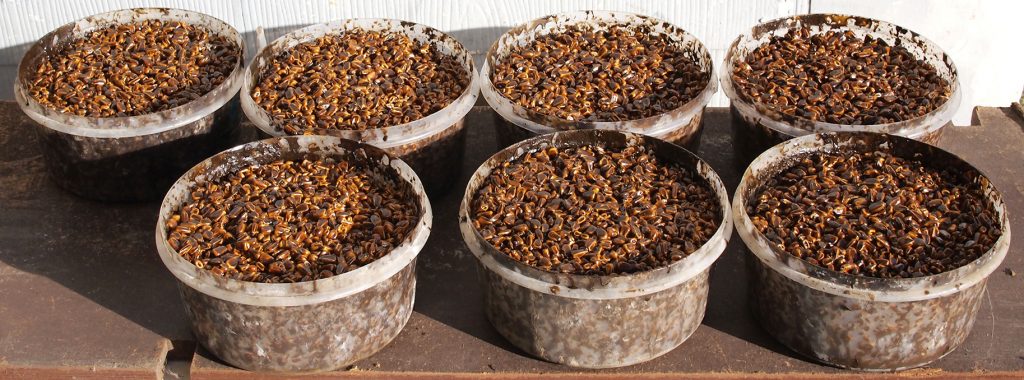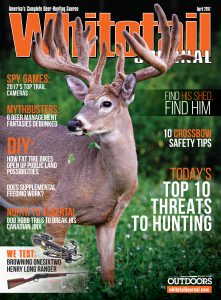A growing number of hunters and land managers are incorporating a supplemental feeding program into their management efforts. It’s not about giving them something to eat, though. Whitetails almost never starve to death. Barring some catastrophic event where adequate nutrition is no longer available, a deer can always find something to munch on. In many regions, though, the natural food sources are a limiting factor in antler growth, body size and overall health of the deer herd. Poor soil leads to marginal plant quality, which leads to average antlers. Instead, those hunters are providing high-quality food for a different reason — big antlers. They insist supplemental foods can compensate for the lack of quality forage and help deer grow bigger antlers and healthier bodies. Does it?
There’s no question providing high-quality food can not only create larger and healthier deer, it can produce considerably larger antlers. Google “trophy whitetails” and you’ll be greeted by countless websites with photos of bucks wearing freakishly large sets of antlers. Take a closer look, though, and you’ll discover those monsters are just that — animals created in a controlled environment where genetic manipulation and carefully chosen food combine to grow huge antlers. Pen-raised deer aren’t the same as free-range whitetails.
So then, does feeding work in the wild? That depends on your definition of “work.” In most instances, according to Auburn University wildlife ecology professor Dr. Steve Ditchkoff, it can actually increase body and antler size.
“Any time you provide high-quality supplemental food, you are helping your deer herd. It’s typically higher in nutritional value than most natural foods, and they don’t have to use much energy to eat,” says Ditchkoff. “It can’t be corn, which provides little nutritional value and adds nothing to antler or body size. Also, supplemental foods must to be freely available instead of on a limited basis. They should be able to eat anytime they want, not just on a limited basis.”
Although there is little research on the impact of supplemental feeding on free-range deer, Ditchkoff says penned deer that have not been subject to any selective breeding programs have shown a substantial improvement in antler size — anywhere from 10 to 30 Boone & Crockett inches for mature bucks.
What’s more, does that have abundant high-quality feed often have more fawns. Those fawns have a higher survival rate. The milk produced by does is higher in vital nutrients, which results in larger and healthier fawns. That, in turn, translates to healthier adults.
Are There Downsides?
That means you’ll need to increase your kill, particularly your doe kill. Since healthier deer have more fawns and higher survival rates, there’s a good chance you’ll see more deer on your land. That’s not necessarily a good thing.
Remember, you aren’t raising cattle in a pasture. Even though you may be providing abundant food, deer still have other needs, including suitable bedding and secure areas. Too many deer can create a virtual desert because even with abundant, high-quality food, they’ll still browse native vegetation. Over-browsing can lead to a significant loss of understory, which translates to a loss cover.
“A supplemental feeding program reinforces our need to be better deer and habitat managers,” says Ditchkoff. “We can’t just feed and forget about everything else. A feeding program adds another layer to the management equation.”
The most obvious drawbacks are that a supplemental feeding program can be time-consuming and expensive. Ditchkoff says a typical whitetail will eat about 2 pounds of feed per day. A feeding program should ideally begin in March and end in October (Always check regulations in your state). That means a single deer can eat nearly 500 pounds of feed per year. At $12 per 50-pound bag, that adds up to about $120 per deer per year. A large farm with a high deer density can cost you thousands of dollars per year.
“You’ll also be feeding non-target animals like raccoons and hogs, which can eat a lot,” he adds.
What’s more, there will be little noticeable results the first or even second year. Ditchkoff says it can take three years for antler sizes to show a significant difference and four years for things to really take off. That’s when fawns that have been raised their entire lives on protein pellets are reaching maturity.
Don’t assume you’ll automatically start seeing and shooting trophy-class bucks, either. An abundance of high-quality food means your deer herd will be fat, happy and lazy. They won’t move much because they don’t need to. Several studies have shown that whitetails turn into nocturnal creatures when they have knowldege that something is hunting them. They are even less likely to move when they have an abundance of high-quality food.
“Success rates for older deer actually go down when supplemental food is provided. You’ll see deer, but it’s unlikely you’ll see mature deer around your feeders during daylight hours unless it’s during the rut,” adds Ditchkoff.
Even if deer do move when you are hunting, they may be moving on the neighbor’s property. All your money and time may be producing bigger, healthier deer not just for you, but for the guys across the fence. And those hunters may not care about letting bucks reach their full potential. They shoot what you don’t. That’s why a feeding program on smaller acreages may be pointless.
“A high-quality food plot can be a lot cheaper than a feeding program,” says Ditchkoff. “Something like soybeans, which have a very high percentage of protein, can provide many of the same things pellets provide and they can keep deer on or at least closer to your property. The only downside is that beans won’t be available until the growing season and they may not last.”

The most obvious drawbacks to supplemental feeding is time consumption and expensive. A typical whitetail deer eats about 2 pounds of food per day.
The Right Way
If you choose to feed, choose products that have 16 to 20 percent crude protein, crude fiber in the 10 to 20 percent range and a 2:1 ratio of calcium and phosphorous. Higher protein levels can lead to digestive problems that may kill deer. Don’t worry about other minerals and elements. Deer do need things like selenium, but they will get what they need through the pellets or through natural forage.
Don’t bother feeding protein pellets in the winter, either. Ditchkoff says protein is generally wasted in the winter. He recommends starting in March or April and ending in October.
How you feed is equally important as what and when you feed. Most important, don’t pour it on the ground. Not only will that make it where you are feeding everything else that finds it, the pellets themselves will likely absorb moisture, which can lead to mold. Deer may not eat the moldy food, but if they do then they can develop digestive problems from the bad food. That’s not something you want.
A better option is a raised trough with some sort of roof over it to prevent rain from falling on the feed. A commercial gravity-fed, tube-type feeder is even better. Not only will they protect the feed from moisture, it will be far enough off the ground that raccoons, hogs and other unwanted visitors won’t be able to devour the pellets.
Such feeders raise the risk of disease transmission, a risk that makes most biologists cringe at the idea of feeding deer. Some states have actually banned feeding deer for that reason. However, Ditchkoff says there is some debate within the wildlife community about the differences between a feeder and a food plot. Both concentrate deer in a small area, raising the risk of disease transmission.
If you choose to feed, make sure you do it right. And above all, don’t stop. Ever. Once you start, you have to keep feeding if you hope to see any results.







